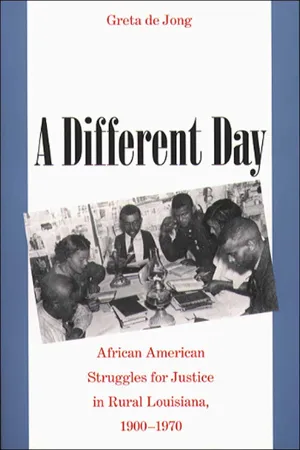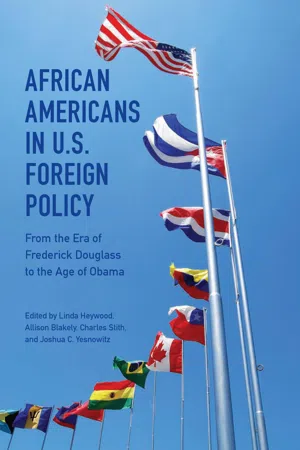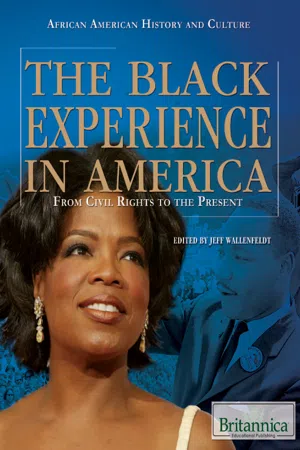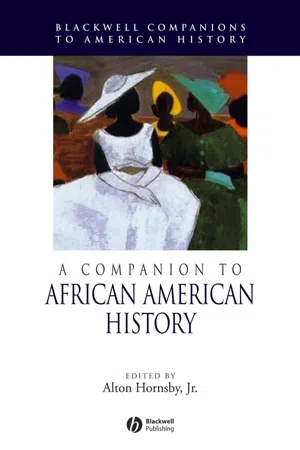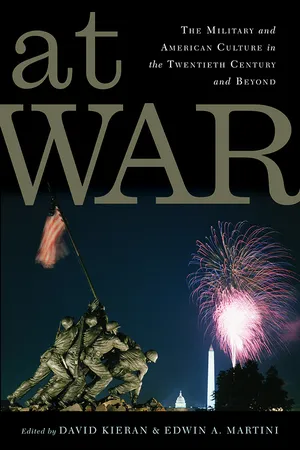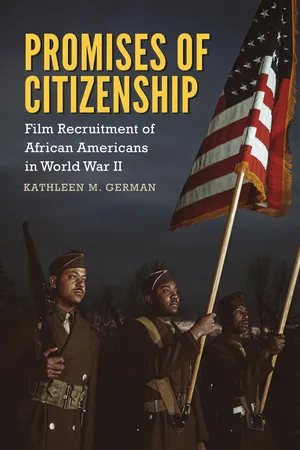History
African Americans in WW2
African Americans played a significant role in World War II, serving in segregated units and facing discrimination both at home and abroad. Their contributions helped to challenge racial segregation in the military and paved the way for the civil rights movement. The war experience also led to increased activism and demands for equality and justice within the African American community.
Written by Perlego with AI-assistance
Related key terms
1 of 5
8 Key excerpts on "African Americans in WW2"
- eBook - ePub
A Different Day
African American Struggles for Justice in Rural Louisiana, 1900-1970
- Greta de Jong(Author)
- 2003(Publication Date)
- The University of North Carolina Press(Publisher)
6 I Am an American Born Negro:
Black Empowerment and White Responses during World War IIThough studies of the civil rights movement generally acknowledge the ideological and economic significance of World War II, the early 1940s have not received nearly the same amount of attention from scholars as the postwar period. Existing histories mostly focus on the activities of national leaders and organizations and the ways they used the war to pressure the federal government to implement antidiscrimination measures.1 Yet the actions of black activists in Louisiana reveal that the freedom struggle was just as intense at the local level.The war brought dramatic changes to the rural parishes. Once again thousands of black people left the region to join the armed forces or to seek industrial employment in urban centers both within and outside the state. Higher incomes and liberation from the control of planters enabled African Americans to launch some powerful offensives against white supremacy during this period. Adopting the slogan of the “Double V” for victory over racism at home as well as abroad, black people worked to bring freedom, equality, and justice not only to the occupied nations but to their own country as well. Newspaper editors and civil rights groups highlighted the contradiction of fighting for democracy overseas while allowing segregation, disfranchisement, and violence against black people to continue in the United States. Soldiers and defense workers protested discrimination in the armed forces and war industry employment. White Louisianans responded by attempting to force their former farm laborers and domestics back into subservience, but they were unable to reverse the massive changes brought about by the war. After World War II, neither the South nor the nation would ever be the same. - eBook - PDF
Personal Perspectives
World War II
- Timothy C. Dowling(Author)
- 2005(Publication Date)
- ABC-CLIO(Publisher)
and to manifest themselves in new and insidious ways. Nevertheless, tem- pered by their wartime experiences, African Americans plunged ahead in their struggles for racial justice, into the period that would become known as the civil rights movement. —Nicolas G. Rosenthal References and Further Reading Bellafaire, Judith A. N.d. The Women’s Army Corps: A Commemoration of World War II Service. Washington, DC: Government Printing Office. Honey, Maureen, ed. 1999. Bitter Fruit: African American Women in World War II. Columbia: University of Missouri Press. Honey, Michael Keith. 1999. Black Workers Remember: An Oral History of Segre- gation, Unionism, and the Freedom Struggle. Berkeley: University of Califor- nia Press. Lemke-Santangelo, Gretchen. 1996. Abiding Courage: African-American Mi- grant Women and the East Bay Community. Chapel Hill: University of North Carolina Press. Malcolm X, with Alex Haley. 1964. The Autobiography of Malcolm X. New York: Grove Press. McGuire, Phillip, ed. 1983. Taps for a Jim Crow Army: Letters from Black Soldiers in World War II. Santa Barbara, CA: ABC-CLIO. Morehouse, Maggi M. 2000. Fighting in the Jim Crow Army: Black Men and Women Remember World War II. New York: Rowman & Littlefield. Motley, Mary Penick. 1987. The Invisible Soldier: The Experiences of the Black Soldier in World War II. Detroit: Wayne State University. Nalty, Bernard C. 1995. The Right to Fight: African American Marines in World War II. Washington, DC: United States Marine Corps. Sugrue, Thomas J. 1996. The Origins of the Urban Crisis: Race and Inequality in Postwar Detroit. Princeton: Princeton University Press. Takaki, Ronald. 2000. Double Victory: A Multicultural History of America in World War II. Boston: Little, Brown. Taylor, Quintard. 1994. The Forging of a Black Community: Seattle’s Central Dis- trict from 1870 through the Civil Rights Era. - eBook - ePub
African Americans in U.S. Foreign Policy
From the Era of Frederick Douglass to the Age of Obama
- Linda Heywood, Allison Blakely, Charles Stith, Joshua C. Yesnowitz, Linda Heywood, Allison Blakely, Charles Stith, Joshua C. Yesnowitz(Authors)
- 2015(Publication Date)
- University of Illinois Press(Publisher)
This dynamic of entering a racialized zone has been well told in U.S. history in the discourses on whiteness, but that narrative may also describe how many immigrants negotiate the U.S. racial system on their way to assimilation and may be applicable to Europe as well. As historian David Blight has noted, “Traditional historians’ treatment of the black experience … was a conscious and deliberate manipulation of history and the stakes were high.” He goes on to explain that “the question of stakes involved in struggle over rival versions of history leads us not only to the political and social meanings of what historians do; it also provides an angle of understanding about the confluences of history and memory for intellectuals and for the larger society.” I suggest that it is not only the filling in of missing histories that may illuminate the context of the African American experience in the military but also how that experience is still written about as supplementary to the dominant context. Another approach may be to look afresh at the entire social history simultaneously and see how American structures and practices of race dismissed and concealed the experience of African American soldiers, and how the shaping of American military experience and war memories was dependent upon the suppression and diminishment of the African American narratives in the very same military organization. For World War I and its aftermath there are a few examples that may tease out the varying dynamics when these stories are told in tandem. 6 Black Doughboys: Real People or Just a Specter? By the time any American soldiers arrived on the war scene, both European and colonial soldiers were exhausted, depleted, and imbued with a weariness described succinctly by the various war poets - eBook - ePub
Africans and the Holocaust
Perceptions and Responses of Colonized and Sovereign Peoples
- Edward Kissi(Author)
- 2019(Publication Date)
- Routledge(Publisher)
3 Africans and World War IIIt is now part of conventional knowledge that the “history” of warfare is more than the story of the soldiers who actually fought on battlefields. It is also the story of the perceptions of war, war propaganda, and the use of war by people who did not fight in it as a conduit for moral conversation.1 The published accounts of the involvement of colonial subjects from Africa in World II are vast. Those that directly relate to the subject of this book have already been reviewed in the introduction. Much of that literature and more beyond it examines the recruitment and deployment of colonial subjects for military service at various theaters of the war, the various war charities set up in the colonies to gather monetary and material contributions to the war effort, the courageous exploits of African soldiers in the service of the Allied Powers, and the disappointments that these soldiers faced when they returned home after the war.2This chapter takes a different angle of analyses from the orthodox approaches in the existing Africanist historiography on the war. It looks at the gathering clouds of war in the 1930s and how Africans understood and interpreted them, how colonial regimes explained the origins and the purpose of war against Nazi Germany and its allies, and how the colonized and sovereign peoples of Africa viewed the Allied explanations and what was at stake for them. The chapter shifts the story of Africans and World War II from the historiography’s dominant focus on how colonial subjects fought the war, or contributed money and materials to it, to an alternative analysis of how Africans, both subject and sovereign, thought about the war, assessed its meaning, and used it as a framework for challenging colonialism and also articulating their own concepts of civilized and ethical conduct in human interactions. Understanding the views and reactions of colonial subjects in Africa and the continent’s two sovereign nations (Ethiopia and Liberia) to World War II requires a new analytical approach: an intellectual and diplomatic history of the Second World War from an African perspective. This chapter provides that. It reaffirms an acknowledged fact in the historiography of the Second World War, as it relates to Africa, that for many people on the continent what became known as “World War II” began much earlier in Africa than it did in Europe with the Italian invasion of Ethiopia in 1935.3 - eBook - ePub
The Black Experience in America
From Civil Rights to the Present
- Britannica Educational Publishing, Jeff Wallenfeldt(Authors)
- 2010(Publication Date)
- Britannica Educational Publishing(Publisher)
CHAPTER 1OVERVIEW : WORLD WAR II TO THE PRESENT
T his study of recent African American history starts with a survey of the period that begins with World War II and continues into the early 21st century. Its primary purpose is to introduce the people, events, organizations, and concepts that will be the focus of more detailed treatment in the ensuing chapters, but it is also intended as a summary that provides sufficient background to allow readers to jump into the rest of the book at any point.WORLD WAR II
The industrial boom that began with the outbreak of World War II in Europe in 1939 ended the Great Depression. However, unemployed whites were generally the first to be given jobs. Discrimination against African Americans in hiring impelled A. Philip Randolph, head of the Brotherhood of Sleeping Car Porters, to threaten a mass protest march on Washington. To forestall the march, scheduled for June 25, 1941, Pres. Franklin D. Roosevelt issued Executive Order 8802 banning “discrimination in the employment of workers in defense industries or government” and establishing a Fair Employment Practices Committee (FEPC) to investigate violations. Although discrimination remained widespread, during the war, African Americans secured more jobs at better wages in a greater range of occupations than ever before.This World War II war bonds poster features a member of the Tuskegee Airmen, the first African American flying unit in the U.S. military. Hulton Archive/Getty ImagesIn World War II as in World War I, there was a mass migration of blacks from the rural South; collectively, these population shifts were known as the Great Migration. Some 1.5 million African Americans left the South during the 1940s, mainly for the industrial cities of the North. Once again, serious housing shortages and job competition led to increased tension between blacks and whites. Race riots broke out; the worst occurred in Detroit in June 1943. - eBook - PDF
- Alton Hornsby, Alton Hornsby, Jr.(Authors)
- 2008(Publication Date)
- Wiley-Blackwell(Publisher)
This need is more urgent than ever as the Second World War generation is dying out. There should be more accounts of how and why blacks responded as they did to the treatment they received in wartime service. Nevertheless, the historiography of black soldiers in both world wars has performed an invaluable service in restoring their brave struggle to historical memory. BIBLIOGRAPHY Works Cited Buckley, Gail (2001) American Patriots: The Story of Blacks in the Military from the Revolution to Desert Storm . New York: Random House. Cooper, Michael (1997) Hellfighters: African American Soldiers in World War I. New York: Lodestar Books. Dalfiume, Richard M. (1969) Desegregation of the Armed Forces: Fighting on Two Fronts, 1939–1953 . Columbia: University of Missouri Press. Edgerton, Robert B. (2001) Hidden Heroism: Black Soldiers in America’s War. Boulder, CO: Westview Press. Foner, Jack (1974) Blacks and the Military in American History . New York: Praeger. Fussell, Paul (2003) The Boy’s Crusade . New York: Modern Library. Henri, Florette and Stillman, Richard Joseph (1970) Bitter Victory: A History of Black Soldiers in World War I . Garden City, NY: Doubleday. Lanning, Michael Lee (1997) The African American Soldier. Secaucus, NJ: Birch Lane Press. McGuire, Phillip (1993) Taps for a Jim Crow Army . Lexington: University Press of Kentucky . Nalty, Bernard C. (1986) Strength for the Fight: A History of Black Americans in the Military . New York: Free Press. Stilwell, Paul (1993) The Golden Thirteen: Recollections of the First Black Naval Officers . Annapolis, MD: U.S. Naval Institute Press. Weinberg, Gerhard L. (1994) A World at Arms . Cambridge: Cambridge University Press. 362 hayward “ woody” farrar Suggestions for Further Reading Barbeau, Arthur E. and Florette, Henri (1974) The Unknown Soldiers; Black American Troops in World War I . Philadelphia: Temple University Press. Biggs, Bradley (1986) The Triple Nickels: America’s First All-Black Paratroop Unit . - eBook - ePub
At War
The Military and American Culture in the Twentieth Century and Beyond
- David Kieran, Edwin A. Martini(Authors)
- 2018(Publication Date)
- Rutgers University Press(Publisher)
Personal Perspectives: World War I (Santa Barbara, CA: ABC-Clio, 2006), 12–13; Richard Stillman, Integration of the Negro in the U.S. Armed Forces (New York: Praeger, 1968), 14.15 On black soldiers’ service in the French Army and their positive experience, see Williams, Torchbearers of Democracy , 93–173; Lentz-Smith, Freedom Struggles , esp. 109–168; Frank Roberts, The American Foreign Legion: Black Soldiers of the 93d in World War I (Annapolis, MD: Naval Institute Press, 2004).16 Sebastian Jobs, Welcome Home, Boys!: Military Victory Parades in New York City 1899–1946 (Frankfurt, Germany: Campus, 2012), 41–72.17 On racial violence, see David F. Krugler, 1919, the Year of Racial Violence: How African Americans Fought Back (New York: Cambridge University Press, 2014); Herbert Shapiro, White Violence and Black Response. From Reconstruction to Montgomery (Amherst: University of Massachusetts Press, 1988); Williams, Torchbearers of Democracy , 249–286.18 Col. Householder, Chief Miscellaneous Division, Tag Dept., in Morris J. MacGregor and Bernhard C. Nalty, Blacks in the United States Armed Forces: Basic Documents (Wilmington, DE: Scholarly Resources, 1977), 5:146. This title encompasses a collection of sources on blacks in the military from the American Revolution to the Vietnam War in thirteen volumes.19 For good overviews of blacks and the Second World War, see Neil Wynn, The Afro-American and the Second World War (New York: Holmes & Meier, 1976); Neil Wynn, The African American Experience during World War II (Lanham, MD: Rowman & Littlefield, 2010); Kimberley Phillips, War! What Is It Good for? Black Freedom Struggles and the U.S. Military from World War II to Iraq (Chapel Hill: University of North Carolina Press, 2012). For a predominantly top-down look at desegregation, see Richard M. Dalfiume, The Desegregation of the U.S. Armed Forces: Fighting on Two Fronts, 1939–53 (Columbia: University of Missouri Press, 1969); Morris J. MacGregor Jr., Integration of the Armed Forces, 1940–1965 (Washington, DC: Center of Military History, 1981), http://www.history.army.mil/html/books/050/50-1-1/index.html ; Sherrie Mershon and Steven Schlossman, Foxholes and Color Lines: Desegregating the U.S. Armed Forces - eBook - ePub
Promises of Citizenship
Film Recruitment of African Americans in World War II
- Kathleen German(Author)
- 2017(Publication Date)
- University Press of Mississippi(Publisher)
CHAPTER SIXMilitary Conditions during World War II
The world’s greatest democracy fought the world’s greatest racist with a segregated army .—STEPHEN AMBROSE 1An overview of United States military history quickly reveals the discrepancy between the principle of harmony touted in The Negro Soldier and the reality of military exclusion. With few exceptions, white Americans in uniform have separated themselves from black Americans since the founding of the nation, mimicking the racial divide of the larger society.2 The armed forces have followed this racial division, generally discouraging or outlawing black participation. Only under the dire circumstances of war, when manpower shortages dictated that blacks be allowed into military service in order to avert defeat, were blacks allowed to serve their country. The conditions in which African American troops served during World War II were multilayered and complex, involving historical traditions of racial segregation, white and black attitudes, eruptions of civilian and military violence, and the realities of wartime. This chapter examines the evolution of military enlistment practices and the structural barriers that blocked African Americans from unconditional participation in military service.Evolution of Military Enlistment Policy
According to the earliest records, both enslaved and free blacks participated in North American military actions starting with the 1528 ill-fated expedition of Panfilo de Narvaez, whose slave Estebanico traveled though northern Mexico sending back reports of golden cities, and continuing to the current conflicts in Afghanistan and Iraq. The first law sanctioning a militia group was passed in 1607, as colonies organized for self-defense against the Native American threat. This original legislation made no reference to race, but by 1639 Virginia had enacted a bill excluding blacks from acquiring arms or ammunition as part of their militia participation. This ban was possibly adopted in response to the increasing number of slaves who, it was feared, would slaughter their masters if armed. The Militia Act of 1792 required every able-bodied citizen to defend the nation. Because militias were controlled by the colonies and later by the states, the practice of raising, training, and supporting militias continued to be patchwork at best. One condition was commonplace, regardless of otherwise inconsistent policies: There was widespread discrimination. The bottom stratum of society was over-represented in the lowest ranks, while sons of wealthy families populated the highest ranks and officer corps.3
Index pages curate the most relevant extracts from our library of academic textbooks. They’ve been created using an in-house natural language model (NLM), each adding context and meaning to key research topics.
